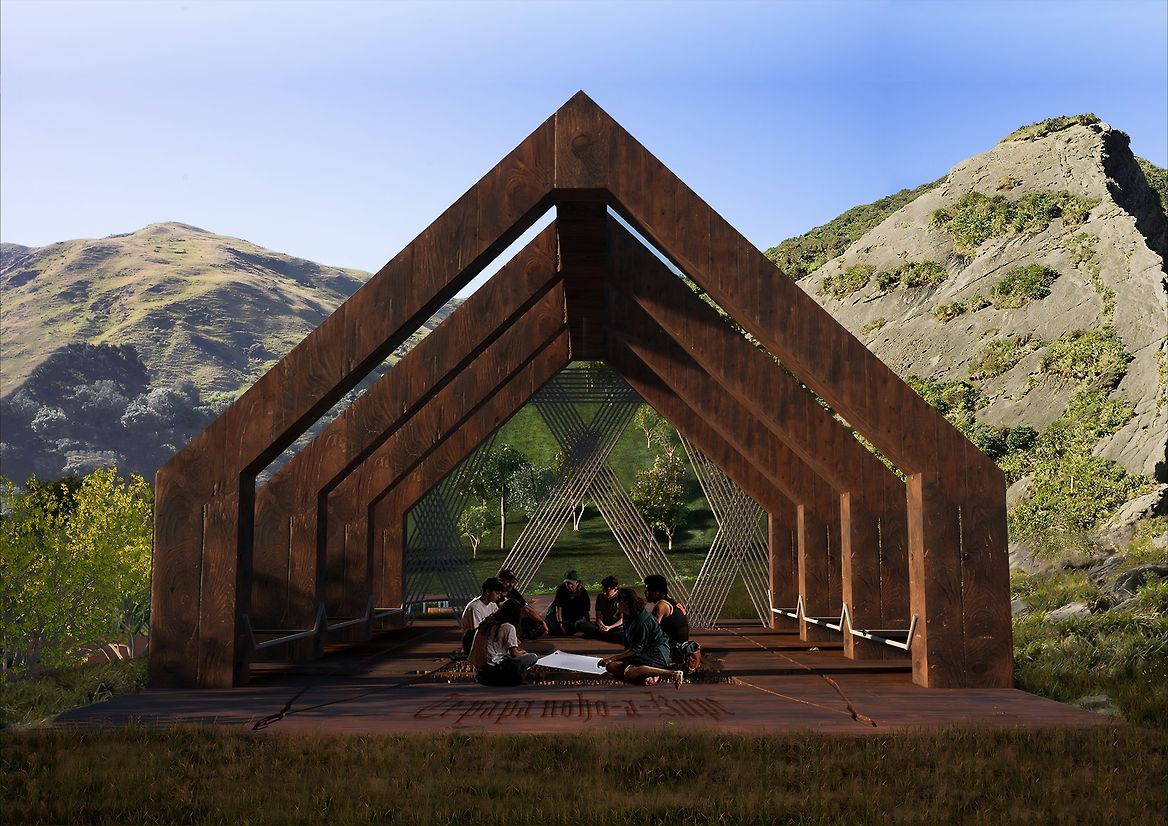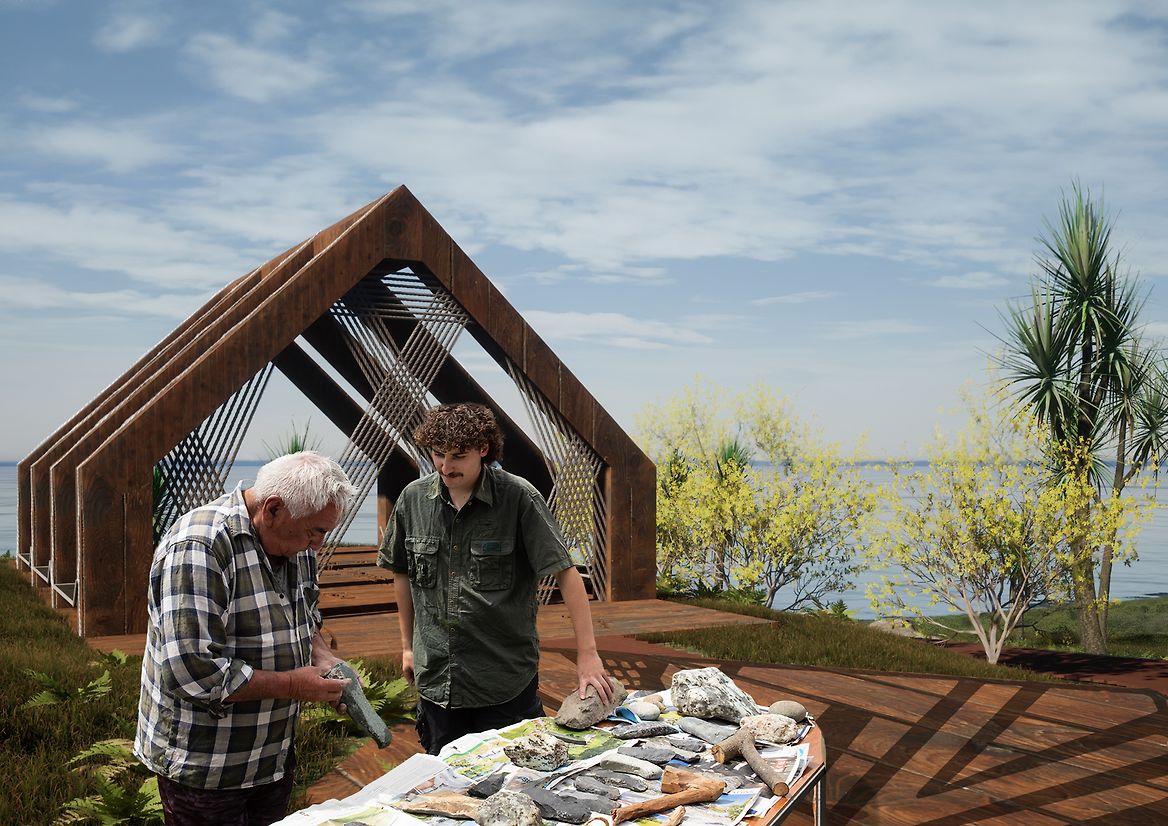Toitanga
Samuel Dunstall - Ngāti Kahungunu, Ngāti Tūwharetoa Te Papa noho-a-Kupe
-
Tauira / Student
Samuel Dunstall - Ngāti Kahungunu, Ngāti Tūwharetoa -
Kaitautoko / Contributors
Ngāti Hinewaka Trust, Ngā Rā-a-Kupe Wānanga Rōpū -
Kaiako / Lecturers
Rongomaiaia Te Whaiti - Ngāti Hinewaka, Ngāti Kahungunu, Ngāi Tahu, Jen Archer Martin - Ngāpuhi, Stuart Foster, Georgina Stokes - Ngāi Tahu










Description:
He aha te mea nui o te ao?
Māku e kī atu,
He tangata, he tangata, he tangata.
Mātakitaki-a-Kupe, the southernmost tip of Te Ika-a-Māui is a convergence point of our Atua, the raw forces, thresholds and interface between their domains. The forest of Tāne bloom amongst the secluded valleys of the Aorangi, his korowai for Papatūānuku. Tangaroa's ocean crest high bringing life and death, and the waters of Parawhenuamea swirl and carve the land, toward the undercurrents of Hine-moana and acidify at the threshold. This area is a thin landing between maunga, moana, awa and ngāhere that amplifies the intensity of these collisions. Ngā Rā-a-Kupe tower over you and cascade down into the depths to join the giant wheke that led Kupe to Aotearoa.
In November of 2022 Ngāti Hinewaka of Ngāti Kahungunu ki Wairarapa welcomed myself and my peers onto Kohunui marae for the ‘Ngā Rā-a-Kupe’ wānanga. The wānanga brought together Māori designers and artists, practitioners and students to experience, understand, interpret and imagine future directions in which Ngāti Hinewaka can share their connection to Kupe and histories of occupation. ‘Ngā Rā-a-Kupe’ kaupapa is an expression of Ngāti Hinewaka mana motuhake, shaped through physical wānanga and held at hapū level. It is an accumulation of mātauranga Māori, driven, shared and understood through our indigenous means of hui, kōrerorero, wānanga and hīkoi.
‘Te Papa noho-ā-Kupe’ is designed as an embodiment of these stories, held within a shared whakapapa. This name derives from the waka hourua, ‘papa noho’ being the observation deck from which the vessel is navigated, sitting below the sails. From this position our tupuna used a number of instruments to guide their voyage, Ātea a Rangi (the celestial star compass), the sun, the moon, the prevailing winds, swells, the flight paths of seabirds and the motions in te taiao.
A trace of the waka is embedded in the ground floor through a CNC machining process, pulling waka and navigational mātauranga toward our whare mātauranga once again. The structure uses the ‘Mīmiro’ technique of compression joints, post tensioning and lashing that is derived from the waka. This technique utilises tī kōuka fibres as cordage to tension the structure and compress the fixing-less joints toward one another. The use of this construction intends to both revive this architectural mātauranga and tie the structure into the kōrero of Kupe.
CNC machining and laminated native timbers allow innovations in Māori architecture, while existing mātauranga informs the mīmiro and lashing details. The materials used are inherently place based, retaining their whakapapa to this rohe. Rākau grow tall and strong in the Aorangi ranges, Rimurimu line the beaches, tī kōuka stand proud overlooking the moana and harakeke adorn the riverbanks. As Māori, our relationships to these materials already exist and are deeper than those to more conventional materials used in modern construction. The materials used in the design entice memory, a feeling of nostalgia and connection. These are the seaweeds, native timbers and fibres.
Grounding Te Papa noho-a-Kupe are ngā rākau taketake, native plantings that provide a spiritual and physical weaving toward Papatūānuku. These plants have been used for kai, medicinal purposes and material resources by Ngāti Hinewaka for generations. Particular species are unique to this remote and coastal environment, such as the Rengarenga lily and Tororaro shrub. This specific kōrero is then unique to Ngāti Hinewaka, and when replanted reinforces as a statement of their presence.
The whare aims to engage manuhiri to the space as a welcome to Mātakitaki-a-Kupe, retelling the stories of the land through its design details while being able to engage deeply and safely with indigenous knowledges, activated through karakia, wānanga and emerging kōrero. The purpose of ‘Te Papa noho-a-Kupe’ is to offer a space to facilitate wānanga on site and to provide context to visitors, the significance of Mātakitaki-a-Kupe and Ngā Rā-a-Kupe as wāhi tapu.
Te Papa noho-a-Kupe stands as a placeholder name until this project is realised, at which point an official name will be given to the whare by Ngāti Hinewaka.
Judge's comments:
This project stands out for its deep integration of cultural narratives and matauranga into modern architectural practice. The ability to weave together the spiritual, historical, and environmental aspects of Ngāti Hinewaka’s connection to Kupe showcases a profound understanding of mana motuhake and mātauranga Māori. The design, ‘Te Papa noho-a-Kupe,’ is not just a physical structure but a vessel of storytelling, rich in toi Māori and imbued with ancestral wisdom.